Handloading/Reloading Ammunition
-
I suddenly recalled this show... was it "The Specialist" or another one which Steven Seagal starred in it... He reloaded his own ammo for another round of usage...

-
Interesting. I did not know South Africa supplied munitions to the SAF.Originally posted by SpecOps87:I don't know if this should be revealed..but take note of the ammo box which shows the manufacturer of our ammo. The country of origin is S.Africa...so mebbe they do the handloading there? But frankly...how much more does a person save with handloading? And does it make more $$ and Sense to buy off the shelf for an army or to do reloading?
Btw Meia...don't mind me asking...you mentioned that the rifle cartridges go through a white-hot flame for annealing, but what about pistol cartridges?
The next time you get an opportunity to do so, take a look at the base of a 5.56mm cartridge. If you see the letters PMP stamped there, it means the cartridge was manufactured by Pretoria Metal Pressings in South Africa. PMP is a division of Denel, South Africa's largest munitions manufacturer. I occasionally come across spent PMP 5.56mm cases at the range here, and have even reloaded a few.
Commercial ammo prices here have skyrocketed in recent years due to the increasing prices of metals on the commodities markets. You do save a lot of money by reloading, particularly in the larger calibers. You also benefit from the ability to customize rounds for individual firearms and/or applications. To give an example, a 50-round box of Winchester 40 S&W 165 gr. range/target ammunition typically goes for around $12. I am able to reload 50 rounds of 40 S&W ammunition, using cleaner-burning powder and with better attention to quality control, for a little under $5 in raw component costs, broken down as follows:
Projectiles: $3.40
Powder: $0.65
Primers: $0.85
Cases: FREE! (Range pick-ups)
Total: $4.90
I haven't come across any pistol cases that are annealed, but that doesn't mean it's not done.
-
Heh MG!
I don;t think all SOuth African Ammo have the PMP becasue that seems to be their commercial line! there is I think 2 to 3 major company ( one of them is Denel and the other is Pretoria Metal Pressings I guess PMP ! ) that produces ammo ! I still have cases of those 300 rd 5.56x45 55 grain battle packs.. and I forgot what they put on it !I will let you know. the 7.62 has R1M1 and the year on the cartridge!
Thanks for the recepie on the 357sig! YEs! I was using normal 9mm bullet and it is not able to seat well! as we charge the ammo and the bullet drop into the cartridge ! I was horrified.
DaveC -
Last time CNN reported the total cost of invading iraq down to the bullets... They stated that it costs 70cents each

-
Here's what happens when a 9mm hollowpoint projectile is shot into a 1 gal. milkjug filled with water:
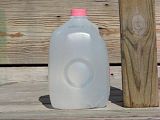
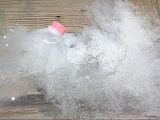
The above images are still frames from the short video I took of the 'experiment'. The gun is off to the left of the screen, approximately 10 feet from the jug. You can download the video here:
http://www.megaupload.com/?d=31T5355D
(The filesize is approximately 4.4 MB and the video is about 5 seconds in length.)
The hollowpoint projectile was recovered from the bottom half of the milkjug. It had evidently mushroomed sufficiently to come to a complete halt within the water in the jug; it did not even hit the wood block behind the jug.
Here are some images of the recovered projectile, showing its terminal 'mushroomed' shape, with the copper jacket peeled back: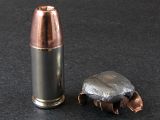
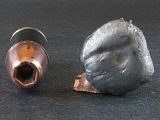
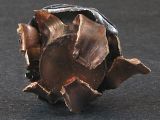
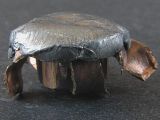

I'd hate to be on the receiving end of that!

-
Is that a hollow point round?
-
Yes. It's a 9mm 124 grain hollowpoint projectile.Originally posted by wonderamazement:Is that a hollow point round? -
What kind of effects are hollow points designed for?Originally posted by Meia Gisborn:Yes. It's a 9mm 124 grain hollowpoint projectile.
I would imagine it is not suitable for any penetration as contact with glass may even flatten it?
So is it correct to say that they are just meant to make a very big hole on human tissues?
How lethal is it and what are the recorded effects on victims? -
Designed to flatten upon impact for more stopping power compare to other FMJ round which has more penetrating power is that right MG?Originally posted by moca:What kind of effects are hollow points designed for?
I would imagine it is not suitable for any penetration as contact with glass may even flatten it?
So is it correct to say that they are just meant to make a very big hole on human tissues?
How lethal is it and what are the recorded effects on victims?
Btw, what does 124 grain means? 124 granules of gunpowder? -
That's about right.Originally posted by wonderamazement:Designed to flatten upon impact for more stopping power compare to other FMJ round which has more penetrating power is that right? MG?
Btw, what does 124 grain means? 124 granules of gunpowder?
Unless it hits bone, an FMJ projectile is likely to pass right through a person.
Ideally, a hollowpoint projectile should 'mushroom' upon entering flesh and come to a rest within the target, dumping most of its energy into the target and creating a much larger wound channel which should prove more lethal.
A grain is an old English unit of measurement, wherein 7000 grains equal one pound. For whatever reason, it is still used in the ammunition industry today as a unit of measurement for power and projectile weights.
The 124 grains mentioned in my previous post refers to the weight of the projectile. 9mm projectiles are generally offered in three weights: 115, 124 and 147 grains, with the first being the most common. -
Some screencaps from another 'water bottle experiment' at the range yesterday morning. This time, it was a 155 gr. 40 S&W hollowpoint projectile fired from my XD-40 Tactical into the base of a two-liter soda bottle filled with water.
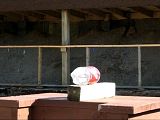
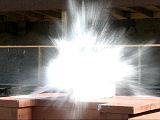
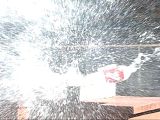
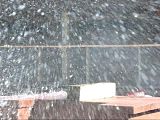
(Click on the thumbnails for the full-size version of each image.)
Didn't manage to recover the projectile, though. It apparently went right through the bottle and into the sand in the backstop.
It apparently went right through the bottle and into the sand in the backstop. -
Did the entire bottle disintegrate? Cool stuff btw!

-
Not completely. There was a split down the side of it, and an entry and exit hole at the bottom and top respectively, but the bottle was still physically in one piece. In the third screencap above, you can see the bottle falling away essentially intact.Originally posted by wonderamazement:Did the entire bottle disintegrate? Cool stuff btw!
What surprised me, though, was the fact that most of the water was actually thrown back at the shooter and camera. In the third and fourth images, you can clearly see where the plume of water is heading.
Mental note: must bring an umbrella the next time I do this again.... -
IntriguingOriginally posted by Meia Gisborn:Not completely. There was a split down the side of it, and an entry and exit hole at the bottom and top respectively, but the bottle was still physically in one piece. In the third screencap above, you can see the bottle falling away essentially intact.
What surprised me, though, was the fact that most of the water was actually thrown back at the shooter and camera. In the third and fourth images, you can clearly see where the plume of water is heading.
Mental note: must bring an umbrella the next time I do this again.... ... Might be the bullet's force pushing it's way through and having no other escape route when the bullet has not blasted the cap off, the water would escape through the buttocks...
... Might be the bullet's force pushing it's way through and having no other escape route when the bullet has not blasted the cap off, the water would escape through the buttocks... 
-
Just curious....any SAF snipers here? Are the rounds for our sniper rifles hand-loaded? or are they bought off the shelf?
-
with the life of your sniper and the outcome of his mission at stake I'm pretty sure they'd fire hand loaded ammunition.

-
I'm not ... but I believe they use lapua rounds .....Originally posted by SpecOps87:Just curious....any SAF snipers here? Are the rounds for our sniper rifles hand-loaded? or are they bought off the shelf?
I actually picked up a fired bullet at pasir laba once, you can tell it's a 7.62 round ... the thing is heavy and solid and jacketed, and totally undeformed other than the usual necked grooves on the sides. -
More fun with water bottles at the range last Friday.
First up: a subsonic 9mm 124 gr. hollowpoint projectile fired into the base of a 2-liter soda bottle:
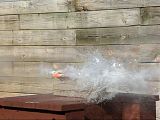


The projectile was not recovered.
Next, another subsonic 9mm 124 gr. hollowpoint projectile fired into a soda bottle, this time with a block of wood behind the bottle in an attempt to stop and recover the projectile: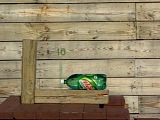
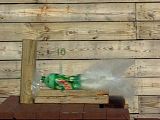

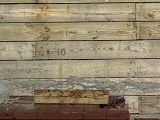
Again, the projectile was not recovered, which was odd, as the block of wood didn't exhibit any impact marks from the projectile. My guess is the projectile was somehow deflected by its passage through the water.
Notice in both instances that there was as much water thrown back at the shooter as forward. -
Just curious...Lapua rounds can't be handloaded?Originally posted by Fatum:I'm not ... but I believe they use lapua rounds .....
I actually picked up a fired bullet at pasir laba once, you can tell it's a 7.62 round ... the thing is heavy and solid and jacketed, and totally undeformed other than the usual necked grooves on the sides. -
With few exceptions, almost any fired brass or nickel-plated brass case that conforms to industry specifications for that particular caliber, can be reloaded several times.Originally posted by SpecOps87:Just curious...Lapua rounds can't be handloaded? -
I am inclined to agree, and recall watching a documentary on The History Channel some years ago about snipers, in which it was mentioned that handloading was the only way to ensure that ammo performance remained consistent.Originally posted by skid:with the life of your sniper and the outcome of his mission at stake I'm pretty sure they'd fire hand loaded ammunition.
The problem with mass-produced commercial ammo is that there are enough variations between production batches to have a noticeable effect on ammo performance. Individual machines at the factory can be set up to load different calibers to meet production demands, and the settings may not remain consistent for any one caliber, resulting in variations in powder weight, bullet seating depth and/or neck crimping. In other words, the box of "premium" ammo you buy today may look and be marked as being identical to the same ammo you bought last month, but if they were produced in different production runs, there is the chance their performance may not be identical. -
I have a theory about the chap who picked up a undeformed bullet.
i once picked up an entire round of 5.56 back at camp while sitting on the grass listening to some briefing. It was a old half-buried training round without the primer cap and 2 tiny holes drilled into the basing.
The bullet was sitting loosely in the casing.
So the undeformed bullet picked up by the chap could've been an unfired bullet that dropped out of its casing, probably from a overused training round.
Anyway...
The training round I picked up in camp I slipped into my pocket unnoticed. But the next day when we went to range, I was wearing the same uniform. When range was over and time to clear arms and declare, I suddenly remembered I still had that training round in my pocket as the NCO's came round with the metal detector!!!
An image of me in a detention cell flashed thorugh my mind in an instance.
Luckily, either the metal detector was crap or the NCOs were sloppy... They didn't find the round even though they did a cursory search of my pockets.
Even though I've never won lottery, I do consider myself lucky sometimes. -
the way to tell a fired bullet and an unfired one is to look at the grooves down the side of the bullet ..... you won't find those grooves made from the grip from the casing from an unfired bullet ....Originally posted by chino65:I have a theory about the chap who picked up a undeformed bullet.
i once picked up an entire round of 5.56 back at camp while sitting on the grass listening to some briefing. It was a old half-buried training round without the primer cap and 2 tiny holes drilled into the basing.
The bullet was sitting loosely in the casing.
So the undeformed bullet picked up by the chap could've been an unfired bullet that dropped out of its casing, probably from a overused training round.
Anyway...
The training round I picked up in camp I slipped into my pocket unnoticed. But the next day when we went to range, I was wearing the same uniform. When range was over and time to clear arms and declare, I suddenly remembered I still had that training round in my pocket as the NCO's came round with the metal detector!!!
An image of me in a detention cell flashed thorugh my mind in an instance.
Luckily, either the metal detector was crap or the NCOs were sloppy... They didn't find the round even though they did a cursory search of my pockets.
Even though I've never won lottery, I do consider myself lucky sometimes.
-
Originally posted by Meia Gisborn:
Sorry for digging up old posts. But yeah, south africa do supply saf with 5.56mm balls round. But only recently like in the past 2 year. As for recycling of spent rounds, saf usually do not reload. The empty brass cart are sold off for money ( now u know why when returning ammo, the weight of RAI returned must be almost 90% of total RAI), and all rounds are brand new. For saf, the rounds usually have a life span of 10 years. If any info is wrong, kindly address it. Hope this clear some doubts.
Interesting. I did not know South Africa supplied munitions to the SAF.
The next time you get an opportunity to do so, take a look at the base of a 5.56mm cartridge. If you see the letters [b]PMP stamped there, it means the cartridge was manufactured by Pretoria Metal Pressings in South Africa. PMP is a division of Denel, South Africa's largest munitions manufacturer. I occasionally come across spent PMP 5.56mm cases at the range here, and have even reloaded a few.
Commercial ammo prices here have skyrocketed in recent years due to the increasing prices of metals on the commodities markets. You do save a lot of money by reloading, particularly in the larger calibers. You also benefit from the ability to customize rounds for individual firearms and/or applications. To give an example, a 50-round box of Winchester 40 S&W 165 gr. range/target ammunition typically goes for around $12. I am able to reload 50 rounds of 40 S&W ammunition, using cleaner-burning powder and with better attention to quality control, for a little under $5 in raw component costs, broken down as follows:
Projectiles: $3.40
Powder: $0.65
Primers: $0.85
Cases: FREE! (Range pick-ups)
Total: $4.90
I haven't come across any pistol cases that are annealed, but that doesn't mean it's not done. [/b]
[/b] -
Actually, those grooves are the impressions left by the rifling in the bore as the projectile is forced down the barrel.Originally posted by Fatum:the way to tell a fired bullet and an unfired one is to look at the grooves down the side of the bullet ..... you won't find those grooves made from the grip from the casing from an unfired bullet ....